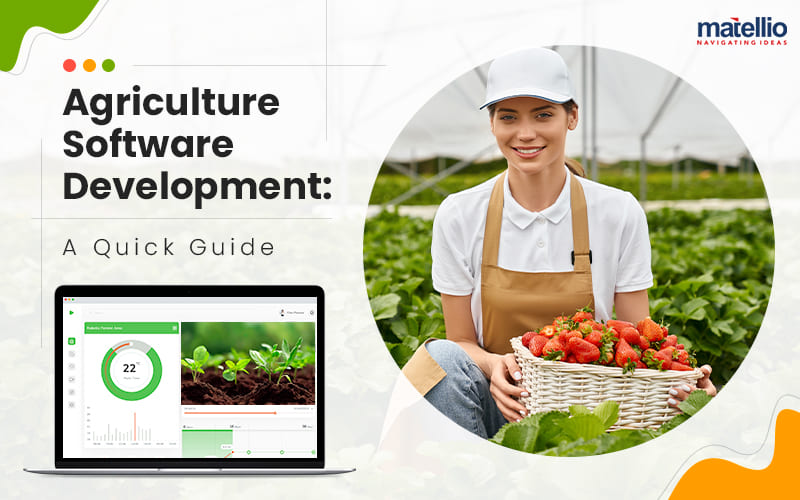Agriculture Software Development: A Quick Guide
The agriculture industry has always played a crucial role globally. As technology advances, it’s no surprise that farm management tools have become an important aspect of modern-day farming. With these agriculture software tools, you can manage your farms more efficiently, revolutionizing how agricultural operations are carried out. In this blog, we’ll delve into the world of agriculture software development and provide a quick guide on how it works, its benefits, and how it can help farmers achieve maximum productivity.
What Exactly is Agriculture Software Development?
Simply put, it involves creating software applications, platforms, and tools tailored to aid farmers in managing their operations effectively. The process utilises technology to develop software to automate various farming processes, including planting, irrigation, and harvesting. Agriculture software development also involves analysing data to provide farmers with valuable insights that can aid them in making better decisions about their operations.
Types of Agriculture Software
Some of the most common types of agriculture software that you can consider include:
| Farm Management Software | It helps farmers to manage their farms effectively by providing features for tracking production, inventory, and finances. |
| Precision Agriculture Software | In this software, sensors and data analytics help farmers with real-time information about their crops, soil, and weather conditions. |
| Livestock Management Software | With this software, farmers manage their livestock by tracking health, breeding, and growth. |
| Irrigation Management Software | Irrigation software is designed to help farmers manage their irrigation systems by providing tools for monitoring water usage, soil moisture, and weather conditions. |
Why Invest in Agriculture Software Development?
Custom agriculture software development offers numerous benefits, such as reducing waste and improving your bottom line. Using software designed specifically for agriculture can streamline your processes, reduce manual labor, and make more informed decisions.
One significant advantage of using agriculture embedded solutions is that it enables you to track essential data, such as crop yields, fertilisation schedules, and weather patterns. By keeping track of this data over time, you can identify trends and make necessary adjustments to improve your operations for maximum efficiency and profitability.
Agriculture software can also assist you in managing your inventory and supply chain more efficiently. By utilising software specifically designed for agriculture, you can effortlessly monitor your inventory levels, order new supplies, and track the delivery of those supplies in real-time. This will reduce waste, ensure you have the necessary supplies, and prevent delays or shortages.
Agriculture software development services offer many benefits and use cases. Here are some examples:
Agriculture Software Innovation
You can use technology and software innovations to improve the efficiency and productivity of your lands and resources. These innovations can also help you to reduce waste, save resources like water, and combat various environmental concerns.
Soil Sensors
Low-cost sensors connected to a cloud-based system can help you monitor the moisture of the soil and the nutrients it needs. This enables you to estimate how much water, fertiliser, and pesticide to provide for your crops, reducing unnecessary consumption of resources and ensuring that the plants receive only the right amount of chemicals for their needs.
Creation of Electronic Field Maps
Electronic field maps are essential for modern agricultural companies worldwide. They provide information on yield, soil types, and diseases. With the help of these maps, you can set thematic layers such as settlements, hydrography, relief, forest belts, and more. Electronic field maps are the foundation of precision farming.
Automated Machines
Automated Machines such as self-driving or smart tractors and drones have become helpful tools for farmers. You can use self-driving vehicles to plant seeds and eradicate weeds. These machines can also apply fertiliser in precise amounts where needed. Drones equipped with high-definition cameras and mapping software can provide detailed information about crop health, including identifying fungi outbreaks and other diseases that may be difficult to spot.
GPS Technology
Livestock GPS technology using the Global Positioning System (GPS) is another useful innovation for farmers. They can attach tracking devices to their livestock’s collars, allowing them to locate any that have wandered off quickly. With this technology, farmers can choose whether to build fences or not. They can also use accelerometers, acoustic devices, and stomach sensors to monitor their livestock’s health. These sensors can notify farmers when their animals are ready to breed, get sick, or require special attention.
A few others are: –
- You can increase your business’s efficiency by automating various farming processes using embedded software, which reduces the time and effort required to manage their operations. Up-to-date and accurate information about agricultural fields, their area, topography, soil specifics, and the condition of stockpiles is crucial to achieving high efficiency in agriculture. Matellio can create agricultural software for farm mapping and other purposes that fully meet farmers’ needs.
- Agriculture software development services help you achieve maximum productivity by optimising your farming processes and making better decisions based on real-time data, thereby improving productivity.
- You can reduce your operational costs by minimising waste, optimising resource usage, and improving crop yields with the help of agriculture software, leading to cost reduction.
- Agriculture software promotes sustainable farming practices by reducing harmful chemicals, optimising water usage, and reducing waste, enhancing sustainability.
Matellio provides bespoke software development services to empower agribusinesses and enables innovative ways for farmers. We offer custom software solutions ranging from remote IoT sensing to AI automation to mapping services to ensure better agricultural operations. As the latest technologies revolutionise the world, farming management software can accomplish various tasks, save time and money, and offer many other benefits. Therefore, it is ideal for farming businesses to build farm management software with rich features.
Moving ahead, let’s discuss this,
Top Must-Have Features to Consider During Agriculture Software Development

Precision Farming
Precision farming functionality involves using technology to precisely target inputs such as water, fertiliser, and pesticides to specific field areas. This feature can help you collect data on soil conditions, crop health, and weather patterns to create highly accurate and detailed maps of their fields. This technology can significantly improve crop yields and reduce costs.
Crop Health Monitoring
This feature can help you monitor crop health using sensors and drones to collect data on plant growth, soil moisture, and other environmental factors.
Livestock Management
This functionality lets you track animal health, breeding, and feeding schedules. This technology can help you decide better when to cull animals, improving overall herd health and productivity.
Yield Mapping
Yield mapping involves collecting data on crop yields and creating detailed maps that show how yields vary across a field. Agriculture software can help you manage this data and use it to make more informed decisions about planting, harvesting, and other farming activities.
Automated Irrigation
Automated irrigation systems can help you save water, reduce labour costs, and improve crop yields. Agriculture software can control these systems, adjusting water levels based on real-time weather data and soil conditions.
Climate Forecasting
Climate forecasting technology can help you predict weather patterns and plan farming activities accordingly. With this feature, you can collect data on temperature, rainfall, and other weather variables and provide farmers with accurate forecasts to help them make better decisions.
Soil Analysis
Soil analysis functionality can help you collect data on soil conditions such as pH, nutrient levels, and compaction. This data can be used to make informed decisions about planting, fertilising, and other farming activities.
Inventory Management
This functionality of agriculture-embedded software will help you keep track of supplies, equipment, and other assets. This technology can improve efficiency and reduce costs by ensuring that farmers have the right equipment and supplies when they need them.
Farm Financial Management
You can keep track of expenses, income, and profits. This functionality can help farmers make more informed decisions about pricing, purchasing, and other financial activities.
Equipment Monitoring
You can keep track of the health and performance of their equipment. This technology can help you identify issues early and take corrective action before equipment fails, reducing downtime and improving efficiency.
Automated Harvesting
Automated harvesting functionality can reduce labour costs and improve efficiency. Agriculture software can control these systems, adjusting harvesting patterns based on real-time crop maturity and yield data.
Field Data Collection
This feature allows you to collect data on soil conditions, crop health, and other environmental factors. This functionality can improve accuracy and reduce labour costs by automating data collection processes.
Traceability
The traceability feature can help you track food movement from the farm to the table. This technology can improve food safety and provide consumers with more information about where their food comes from.
Moving ahead, let’s discuss this,
How to Develop Agriculture Software Development?
Agriculture software development typically involves the following steps:
![]()
Define the Problem
Determine the needs of the target audience, such as farmers, agronomists, or other professionals in the agriculture industry. After gathering this information, you need to analyse it and identify the core problems that the software aims to solve. You should prioritise these problems based on their severity, frequency, and impact on the target users.
![]()
Develop a Plan
After identifying the problem and researching the industry, market trends, and user needs, the agriculture software development team should develop a plan outlining the project’s scope, objectives, and timeline.
The plan should start with clearly defining the problem the software aims to solve and summarising the research findings. It should then outline the software’s features and functionalities, which should be based on the users’ needs and expectations.
The development team should prioritise the features based on their importance, complexity, and feasibility. The team should also break down the project into smaller tasks and evaluate the time and resources required to complete each task. This can help the team to create a realistic timeline for the project.
![]()
Design and Prototype
The design phase involves creating the software’s user interface, user experience, and overall visual design. A software prototype is created to test and refine the design and functionality.
Our UX audit helps identify user frustrations and budding obstacles to the success of your solution. It is an effective method to reduce development costs and increase your ROI in the long term. During the audit, we examine your solution’s design to enhance user flows, eliminate pain points, and correct design flaws.
![]()
Develop the Software
Once the prototype is finalised, development can begin. The agriculture custom software development process involves coding and testing the software to ensure it works as intended.
The development team should follow best practices and coding standards to ensure the software meets the users’ needs and expectations while being efficient, maintainable, and scalable.
Also Read: What are the Top Benefits of Bespoke Software Development?
![]()
Quality Assurance and Testing
The QA process involves testing the software for bugs, errors, and other performance and functionality issues. The development team should conduct various tests, including functional testing, performance testing, security testing, and compatibility testing, to ensure that the agriculture software meets the requirements and specifications defined in the plan.
The team should also collect user feedback and address any issues users report. This can involve fixing bugs, improving the software’s features and functionalities, and enhancing its user interface.
Conclusion
The field of agriculture software development is rapidly growing and has transformed how farmers manage their operations. With the assistance of agriculture software, farmers can maximise productivity, minimise costs, and promote sustainable farming practices. Various types of agriculture software are available today, each with unique features and benefits.
Agriculture software development is the solution if you’re a farmer seeking to streamline your operations and achieve maximum efficiency. Using agriculture software can take your business to the next level and increase efficiency and profitability. When choosing software for your business, ensure it is scalable, user-friendly, and integrates with your existing processes.
With the right software, you can optimise operations, reduce waste, and succeed in agriculture. Matellio is a top agriculture app development company, and our skilled mobile app developers are proficient in building exceptional agriculture apps. Have a project in mind? Why not test our skills? We can help you create customised software and mobile app solutions for your business.





